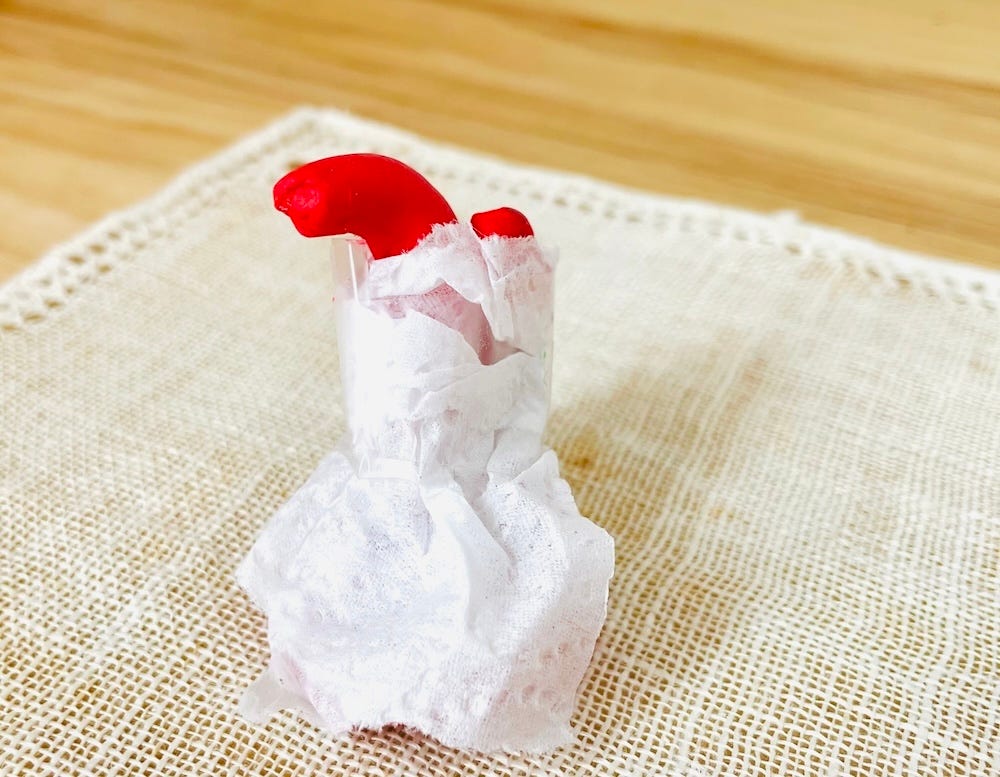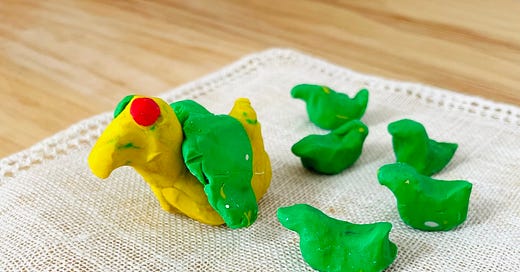I’m in North Carolina helping to care for my ninety-two-year-old dad. I was working on this essay prior to coming, and it was helpful to finish it here and remember that despite being in the midst of things that are difficult or unhappy, I can smile and actually be happy in moments. Others find solace in my happiness too.
Seeing pictures of the clay figures my grandson and I make together sprinkled throughout this essay, reminded me how wholeheartedly we are involved with each other when we play together. So I just drop everything and play.

A few months ago my son and daughter-in-law invited me to make art once a week with my grandson. Simply hearing the request caused me to feel overcome with inadequacy. Suddenly I had to be “a real artist” (someone with a degree) to “teach” art to my grandson, despite years as a collage and mixed media artist and illustrator, and even despite all the hours of art-making we had already done together.
I anxiously contacted several art teacher friends, including one who taught Waldorf, and they all said the same thing: bring stuff and let him play; don’t take it personally if he doesn’t want to do any of it, or just wants to do it for a few minutes, or wants to do something unplanned with some or all of the materials.
I was already doing all of that.
What fear drives us to think we must “be something,” blinding us to all we already are, and have always been?
The fear of not being a “real artist” dogged me much of my adult life. It’s taken years of cultivating self-awareness and compassion to see it, but every so often it pops up with a vengeance and I’m lost in old thoughts and beliefs. This time I thought: what can I get him to produce that would show my son and daughter-in-law I was doing a good job? Friends and deep breathing helped me recognize the old fear. It was impossible to fail anyone unless I continued to believe I could, or would.
This is the real secret of life -- to be completely engaged with what you are doing in the here and now. And instead of calling it work, realize it is play. ~Alan Watts, author
Open-ended art making is a form of play, and a wonderful arena to dance with fear and practice foolishness. Children create fearlessly, but over time we saddle them with nonsensical boundaries—“skies are blue not green” or “color inside the lines.” As adults we know creativity requires fearlessness and a willingness to make mistakes, and we try to play/create while juggling a fear of failure, or of looking foolish—difficult if not impossible.
Play is bound up with creativity but it is totally for itself. It does not have to be connected to something, or produce anything. It does not have to lead us anywhere. It is it’s own thing, and it’s open-ended unpredictability is its great pleasure.
Mindfulness, awareness, attention—whatever we call it—is like this. It’s enough to simply be mindful and pay attention using the breath, or some other somatic practice like yoga or qigong or just walking with intention. Whatever practice we do is its own thing and doesn’t need to lead to, or produce, anything. They seem to help us become more patient and kind, empathic and self-compassionate, but the conundrum is to practice without any desire to acquire any of those things.
Striving doesn’t liberate, but simple presence without expectation and judgement seems to.
My grandson has three stuffed animal friends—Dinoey, Dragoney and Puppy—and when I visit, I (Nana), am the voice for all of them, as well as the growing coterie of clay animals we’re creating together. Recently he was talking to Dinoey, a red tyrannosaurus rex with those little forearms and big white teeth made of felt, when the T-rex asked for a sip from his juice box.
My grandson looked at me very seriously and said, “He can't have any juice because he’s not real—see.” Then he pulled open Dinoey’s mouth and solemnly showed me an expanse of red cloth surrounded by white felt teeth. He broke the fourth wall to correct me, despite the fact that Dinoey had, in the past, drank many glasses of juice. The next moment he was happily feeding Dinoey a slice of cucumber, and Dinoey happily ate it.

A four-year-old will teach you to pass back and forth between the worlds of real and pretend with incredible fluidity—if you’re willing. Or if you’re willing to reconnect with your inner four-year-old.
Give a nod to the real then play and pretend with your whole heart.
The benefits of play can include social emotional wellness, and the benefits of meditation and mindfulness can include inner calm, mental clarity and so on. But a culture focused on goals and getting often creates goals out of perceived benefits. In other words, if people can “get” calm with mindfulness, or experience social emotional wellness through play, someone, some institution, will develop a program with “measurable results,” brand it, and develop activities to help people “reach” those goals. Money is usually involved.
But the benefits of play, meditation etc. are often amorphous, a little mysterious, often unique to the individual, and notoriously hard to measure in scientific studies. Responses and benefits depend on individual effort, but also on the social environments where people life and work—the social determinants of health.
But it’s like teaching art to children: offer the materials—practices—and see what happens.
We don’t teach uncertainty in schools. It should be the absolute bedrock of what we teach children – how we come to know and how we describe reality. In fact, we teach the exact opposite. ~Adam Rutherford, science writer
Meditation has been a benefit to me, which is why I talk and write about it. It’s led to more self-awareness, kindness, calm, and less reactivity to name a few, but I’ve slowly stopped expecting those things to happen. Every moment is different. Taking a breath when faced with my father’s loneliness, and taking a breath when someone cuts me off in traffic will not offer the same options, or soothe in the same way.
There are many reasons adults stop playing and pretending, but something I particularly notice now that I’m playing again with activities I have always loved, like collage-making, writing essays and poetry—there is much less satisfaction, and over time much less interest, in things modern society holds up as worthy or successful. It feels scary to let go of what the culture thinks is important.
But go there anyway. Play for the sake of play. Meditate for the sake of meditating. Be kind for the sake of being kind. It won’t “get” you anywhere—what a relief!
**I’m a mindfulness teacher and coach, helping clients reclaim their attention and deepen their spiritual practices. To work with me, message me on Substack, LinkedIn or through my website. **I’m an essay writer and poet. Contact me for collaborations or guest posts.
References






Yes, play and meditation, and Alan Watts. Add to that a 4 year old, and that has to be a recipe for enjoyment!